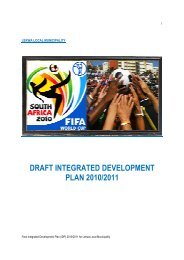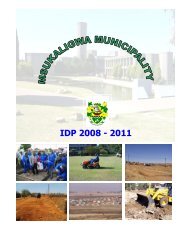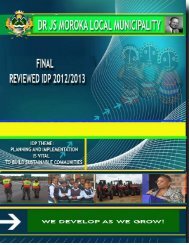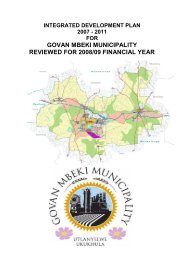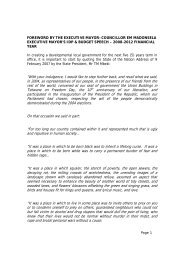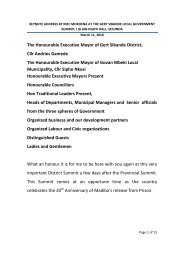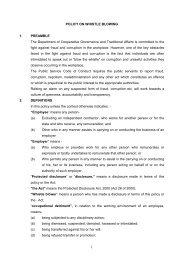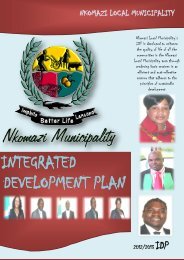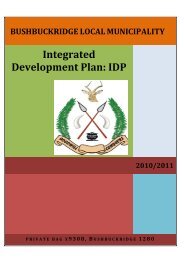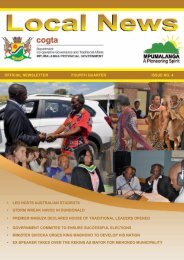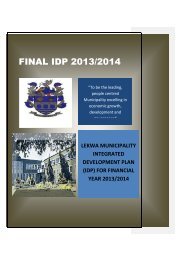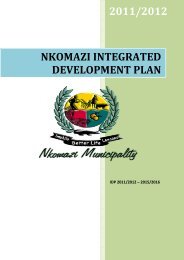Govan Mbeki Local Municipality 2011/12 - Co-operative ...
Govan Mbeki Local Municipality 2011/12 - Co-operative ...
Govan Mbeki Local Municipality 2011/12 - Co-operative ...
Create successful ePaper yourself
Turn your PDF publications into a flip-book with our unique Google optimized e-Paper software.
coefficient<br />
2009<br />
African 0.51 0.59<br />
White 0.88 0.43<br />
<strong>Co</strong>loured 0.70 0.65<br />
Asian 0.79 0.51<br />
Total 0.59 0.66<br />
Source: Global Insight: Regional eXplorer 388 (2.2b)<br />
Gini <strong>Co</strong>efficient<br />
IHS Global Insight (2009) defines the Gini coefficient is a summary statistic of income<br />
inequality, which varies from 0 (in the case of perfect equality where all households<br />
earn equal income) to 1 (in the case where one household earns all the income and<br />
other households earn nothing). A low Gini coefficient indicates more equal income<br />
or wealth distribution, while a high Gini coefficient indicates more unequal<br />
distribution. In practice the coefficient is likely to vary from approximately 0.25 to<br />
0.70.<br />
In terms of Table 3 above, most Gert Sibande local municipalities have relatively high<br />
Gini coefficients or high levels of income inequality. While the levels of inequality are<br />
broadly characteristic of the broader South Africa, the fact that they have continued<br />
to increase since 1996 and remain above the national level is a cause for great<br />
concern.<br />
<br />
Income Poverty<br />
Poverty is often defined as deprivation of those things that determine the quality of<br />
life, including food, clothing, shelter and safe drinking water, as well as "intangibles"<br />
such as the opportunity to learn and to enjoy the respect of fellow citizens. One of the<br />
important indicators of poverty in a region is the number of households with an<br />
income below the Minimum Living Level (MLL). The MLL is annually determined by<br />
the Bureau of Market Research (UNISA). It is calculated for different regions, racial<br />
groups, household sizes, and reflects the minimum amount a household needs to<br />
earn to meet its basic needs.<br />
IHS Global Insight D307<br />
Development<br />
MP307: <strong>Govan</strong> <strong>Mbeki</strong> <strong>Local</strong> <strong>Municipality</strong><br />
Poverty indicators<br />
Percentage of people in poverty<br />
Number of<br />
people in<br />
poverty 1996 2009 1996 2009<br />
African 62,670 102,837 37.8% 40.1%<br />
White 1,627 404 4.1% 1.0%<br />
<strong>Co</strong>loured 486 820 19.9% 34.6%<br />
Asian 94 246 4.5% 9.7%<br />
Total 64,877 104,306 30.8% 34.7%<br />
Regional eXplorer 524 (2.3e)<br />
In terms of Table 3 above Mkhondo municipality has the highest number (69.5%) of<br />
people living below the MLL ,while the number is lowest (35,6%) in <strong>Govan</strong> <strong>Mbeki</strong>.<br />
While it is encouraging that poverty rates have declined across all municipalities<br />
since 2001 they remain above the national rate of 42.9%. The decline has been<br />
widely attributed to the extension of the state’s social security network.<br />
24



